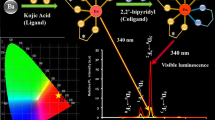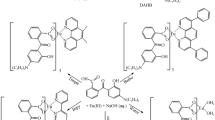Abstract
Ternary materials of europium complex with 2,2,6,6-tetramethyl-3,5-heptanedione (tmhd) ligand and aqua ligand as ancillary ligands have been prepared and characterized for various optoelectronic characteristics. Reactions of hydrated complex [Eu(tmhd)3(H2O)2] proceeded with triphenylphosphine oxide (TPPO) and pyridine-N-oxide (PNO) ancillary ligands were studied to develop novel complexes. The prepared complexes show good thermal stability. A comparative investigation of prepared materials [Eu(tmhd)3(H2O)2], [Eu(tmhd)3(TPPO)2] and [Eu(tmhd)3(PNO)2] was conducted for their luminescent behaviors in order to obtain the role of ancillary ligand in the enhancement of illumination amount generated from europium (Eu3+) ion. Color coordinates of prepared ternary complexes such as [Eu(tmhd)3(H2O)2] with (x = 0.54, y = 0.32), [Eu(tmhd)3(TPPO)2] with (x = 0.56, y = 0.32) and [Eu(tmhd)3(PNO)2] with (x = 0.57, y = 0.33) indicated that these materials exhibited bright red emission in visible region spectrum. The complexes show a proficient energy transport pathway from the ligands to the innermost Eu3+ by means of an ancillary ligand-sensitized luminescence process. Interaction between the metal and ligand results in a distinguished effect on quantum efficiency (η) as well as on Judd–Ofelt intensity factor (Ω2) of the prepared materials.
Graphic abstract











Similar content being viewed by others
References
Binnemans K. Lanthanide-based luminescent hybrid materials. Chem Rev. 2009;109(9):4283.
Zheng K, Liu Z, Jiang Y, Guo P, Li H, Zeng C, Ng SW, Zhong S. Ultrahigh luminescence quantum yield lanthanide coordination polymer as a multifunctional sensor. Dalton Trans. 2018;47(48):17432.
Kitagawa Y, Suzue F, Nakanishi T, Fushimi K, Hasegawa Y. A highly luminescent Eu(III) complex based on an electronically isolated aromatic ring system with ultralong lifetime. Dalton Trans. 2018;47(21):7327.
Kitagawa Y, Ohno R, Nakanishi T, Fushimi K, Hasegawa Y. Solvent-dependent dual-luminescence properties of a europium complex with helical π-conjugated ligands. Photochem Photobiol Sci. 2017;16(5):683.
He P, Wang H, Liu S, Hu W, Shi J, Wang G, Gong M. An efficient europium(III) organic complex as red phosphor applied in LED. Electrochem Soc. 2009;156(2):E46.
Law GL, Wong KL, Tam HL, Cheah KW, Wong WT. White OLED with a single-component europium complex. Inorg Chem. 2009;48(22):10492.
Wang QM, Ogawa K, Toma K, Tamiaki H. Smart pH sensitive luminescent hydrogel based on Eu(III) β-diketonate complex and its enhanced photostability. J Photochem Photobiol A. 2009;201(2–3):87.
Dong H, Liu Y, Wang D, Zhang W, Ye Z, Wang G, Yuan J. Preparation of europium-quantum dots and europium-fluorescein composite nanoparticles available for ratiometric luminescent detection of metal ions. Nanotechnology. 2010;21(39):395504.
Mukkala VM, Helenius M, Hemmilä I, Kankare J, Takalo H. Development of luminescent europium(III) and terbium(III) chelates of 2,2′:6′,2″-terpyridine derivatives for protein labeling. Chim Acta. 1993;76(3):1361.
Hemmila I, Laitala V. Progress in lanthanides as luminescent probes. J Fluoresc. 2005;15(4):529.
Mesquita ME, Nobre SS, Fernandes M, Ferreira RAS, Santos SCG, Rodrigues MO, Carlos LD, Bermudez VD. Highly luminescent di-ureasil hybrid doped with a Eu(III) complex including dipicolinate ligands. J Photochem Photobiol A. 2009;205(2–3):156.
Werts MHV, Woudenberg RH, Emmerink PG, Gassel RV, Hofstraat JW, Verhoeven JW. A near-infrared luminescent label based on YbIII ions and its application in a fluoroimmunoassay. Angew Chem Int Ed. 2000;39(24):4542.
Sabatini N, Guardigli M, Lehn JM. Luminescent lanthanide complexes as photochemical supramolecular devices. Coord Chem Rev. 1993;123(102):201.
Binnemans K. Rare-earth beta-diketonates. Handbook on the physics and chemistry of rare earths. Amsterdam: Elsevier; 2005. 107.
Irfanullah M, Iftikhar K. Hypersensitivity in the luminescence and 4f–4f absorption properties of mono- and dinuclear EuIII and ErIII complexes based on fluorinated β-diketone and diimine/bis-diimine ligands. J Fluoresc. 2011;21(1):81.
Sato S, Wada M. Relations between intramolecular energy transfer efficiencies and triplet state energies in rare earth β-diketone chelates. Bull Chem Soc Jpn. 1970;43(7):1955.
Crosby GA, Whan RE, Alire RM. Intramolecular energy transfer in rare earth chelates role of the triplet state. J Chem Phys. 1961;34(3):743.
Haynes AV, Drickamer HGJ. High pressure luminescence studies of energy transfer in rare earth chelates. Chem Phys. 1982;76(1):114.
Irfanullah M, Iftikhar K. New hetero-dilanthanide complexes containing Ln1(fod)3 and Ln2(fod)3 fragments (Ln=Pr–Nd; Nd–Sm; Eu–Tb and Ho–Er) linked by bis-diimine bridging ligand. Inorg Chem Commun. 2010;13(6):694.
Bunzli JCG, Piguet C. Taking advantage of luminescent lanthanide ions. Chem Soc Rev. 2005;34(12):1048.
Wang D, Pi Y, Zheng C, Fan L, Hu Y, Wei X. Preparation and photoluminescence of some europium(III) ternary complexes with β-diketone and nitrogen heterocyclic ligands. J Alloys Compd. 2013;574(1):54.
Wang D, Zheng C, Fan L, Zheng J, Wei X. Preparation and fluorescent properties of europium(III) complexes with β-diketone ligand and 2,2-dipyridine or 1,10-phenanthroline. J Synth Met. 2012;162(23):2063.
Kumar MVV, Jamalaiah BC, Gopal KR, Reddy RR. Novel Eu3+-doped lead telluroborate glasses for red laser source applications. J Solid State Chem. 2011;184(8):2145.
Raju BDP, Reddy CM. Structural and optical investigations of Eu3+ ions in lead containing alkali fluoroborate glasses. Opt Mater. 2012;34(8):1251.
Smentek L, Kedziorski A. f ↔ f electric dipole transitions; old problems in a new light. J Alloys Compd. 2009;488(2):586.
Wybourne BG, Kedziorski A. Magnetic dipole transitions in crystals: II. Perturbation approach. J Alloys Compd. 2008;451(1–2):18.
Soares-Santos PCR, Nogueira HIS, Felix V, Drew MGB, Ferreira RAS, Carlos LD, Trindade T. Novel lanthanide luminescent materials based on complexes of 3-hydroxypicolinic acid and silica nanoparticles. Chem Mater. 2003;15(1):100.
De Sa GF, Malta OL, de Mello DC, Simas AM, Longo RL, Santa-Cruz PA, da Silva EF Jr. Spectroscopic properties and design of highly luminescent lanthanide coordination complexes. Coord Chem Rev. 2000;196(1):165.
Carlos LD, Messaddeq Y, Brito HF, Ferreira RAS, Bermudez VD, Ribeiro SJL. Full-color phosphors from europium(III)-based organosilicates. Adv Mater. 2000;12(8):594.
Werts MHV, Jukes RTF, Verhoeven JW. The emission spectrum and the radiative lifetime of Eu3+ in luminescent lanthanide complexes. Phys Chem Chem Phys. 2002;4(9):1542.
Zhang X, Zhou L, Pang Q, Gong M. Photoluminescence and Judd–Ofelt analysis of red LiGd5P2O13:Eu3+ phosphors for white LEDs. RSC Adv. 2015;5(67):54622.
Yakuphanoglu F, Arslan M. The fundamental absorption edge and optical constants of some charge transfer compounds. Opt Mater. 2004;27(9):29.
Acknowledgement
This work was financially supported by the program from the SERB-DST, New Delhi (No. EMR/2016/006,135).
Author information
Authors and Affiliations
Corresponding author
Rights and permissions
About this article
Cite this article
Singh, D., Bhagwan, S., Dalal, A. et al. Oxide ancillary ligand-based europium β-diketonate complexes and their enhanced luminosity. Rare Met. 40, 2873–2881 (2021). https://doi.org/10.1007/s12598-020-01543-w
Received:
Revised:
Accepted:
Published:
Issue Date:
DOI: https://doi.org/10.1007/s12598-020-01543-w




